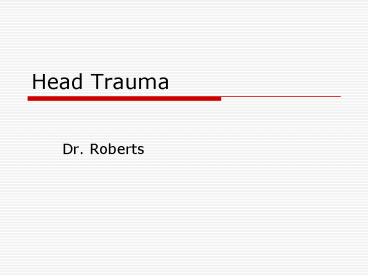Head Trauma - PowerPoint PPT Presentation
1 / 20
Title:
Head Trauma
Description:
Head Trauma Dr. Roberts Epidemiology 1.1 million annual ED visits Highest 85 yo 80% minor head trauma (GCS 14-15) 10% moderate (GCS 9-13) & 10% severe (8 ... – PowerPoint PPT presentation
Number of Views:150
Avg rating:3.0/5.0
Title: Head Trauma
1
Head Trauma
- Dr. Roberts
2
Epidemiology
- 1.1 million annual ED visits
- Highest lt 5 yo gt85 yo
- 80 minor head trauma (GCS 14-15)
- 10 moderate (GCS 9-13) 10 severe (8 below)
- 200,000 deaths, most under 25 yo 40 firearm
related 34 MVC
3
Anatomy
- Brain covered in multiple layers 1. dura 2.
arahnoid 3. pia - Subarchnoid space contains 150cc CSF 500 cc made
each day - Normal CSF pressures 5-15 mmHg
- Scalp 1. skin 2. subcutaneous, 3. galea, 4.
areolar 5. pericranium - rich blood supply
4
Pathopphysiology
- Two main mechanisms of injury
- Primary initial mechanical trauma (irreversible)
- Secondary hypotension hypoxia anemia (our job)
- Cushings ReflexHypertension bradycardia
respiratory irregularity - Cerebral herniation
- Central Transtentorial-expanding lesion at
frontal or occipital poles AMS, pinpoint pupils,
bi-muscle weakness - Cerebellotonsillar-cerebellar tonsils herniate
through foramen magnum due to cerebellar mass
Pinpoint pupils, quadriplegia and
cardiorespiratory collapse - Upward Transtentorial-expanding posterior fossa
lesion pinpoint pupils, absence of vertical eye
movements - Uncal-most common, usually due to hematoma, 3rd
nerve compression (anisocoria, ptosis, sluggish
pupil, CN III defects)
5
Types of herniation
- Upward Transtentorial
- Central Transtentorial
- Uncal
- Cerebellotonsillar
6
Initial ED Evaluation Tx
- History
- High Risk prolonged amnesia, anticoagulation,
coagulopathy, progressive vomiting, post injury
seizure - Physical Exam-Neuro Exam (GCS)
- High Risk focal neuro findings, distracting
injury, signs of skull fracture, large
extracranial hematoma, intoxication - ABCs (consider lidocaine if RSI)
- Maintain PO2 MAP
- Watch for cushings
- CT if GCS lt 14, high risk Hx or Exam
7
Further ED Management
- Indications for Seizure Prophylaxis
- Depressed skull fracture
- Paralyzed Intubated patient
- Seizure at time of injury
- Seizure in ED
- Penetrating brain injury
- GCS lt9
- Acute Subdural/Epidural hematoma
- Intracranial hemorrhage
- Prior history of seizure
8
9
Fig. 255-3.
10
Fig. 255-5.
11
Specific Head Injuries
- Scalp Lac direct pressure, lido with epi,
explore wound, suture/staples
12
Skull Fractures
- Linear simple comminuted fx irrigate, suture,
antibiotics per neuro surg consult - Basilar CSF otorrhea/rhinorrhea, battles,
raccoon, hemotympanum, vertigo, CN VII palsy,
deafness, antibiotics usually not warrented
13
Specific Injuries
- Cerebral Contusion frequent injury, coup vs
contre-coup, often with subarachnoid bleed,
initial scans may be normal
14
Subarachnoid Hemorrhage
- Disruption of small subarachnoid vessels
- Only detected 33 on initial CT
- Most common abnormality on Head CT
- Show signs of photophobia headache
- Marks significant increase morbidity/mortality in
severe head injury
15
Subdural Hematoma
- Blood clot between dura and brain
- Seen in acceleration-deceleration injuries
- Common in alcoholic elderly
- Rupture of superficial bridging vessels
- Acute-symptoms in 1st 24 hrs (lucid interval)
- Subacute-symptoms between 24 hrs-2 wks
- Chronic-symptoms after 2 wks
16
Epidural Hematoma
- Collection of blood between skull dura due to
blunt trauma causing rupture of middle meningeal
artery - May have a lucent period following immediate LOC
- Due to arterial bleeding, herniation occurs
quickly
17
Concussion
- Temporary brief interruption of neurologic
function after minor trauma - Symptoms-headache, confusion, amnesia
- Should not return to play until resolution of
symptoms for 1 week
18
Pediatric Head Trauma
- lt2yo consider abuse
- Higher mortality in children
- lt3months asymptomatic, no scalp hematoma then no
CT - 3months-2yrs scalp hematoma present then skull
films, if fracture CT - gt2yrs CT if high risk PE or history
19
Penetrating Head Injuries
- ABCs
- Antibiotics Td proph
- CT Neurosurgery
20
The End































